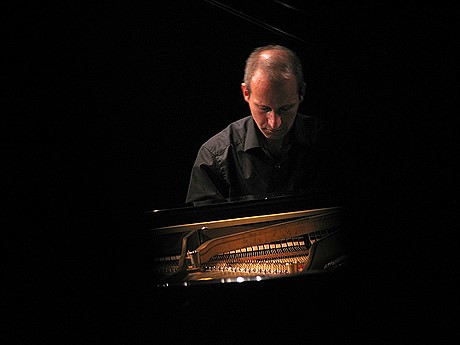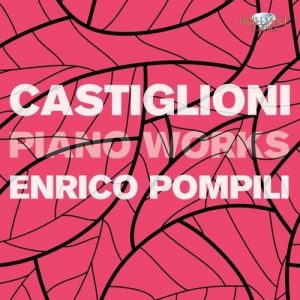A native of Bolzano, Italian pianist Enrico Pompili won several national competitions before being one of the finalists at the Dublin International Piano Competition. In 1994 he was second to Viktor Lyadov at the Hamamatsu Competition, and the following year he was awarded the top prize at the XIII Paloma O’Shea Competition. This success launched an international career starting from 1996. An ardent explorer of contemporary repertoire Pompili has put the spotlight on for example Niccolò Castiglioni on the Col Legno label, Alberto Ginastera’s complete piano works, and works by Alberto Bonera (Phoenix Classics). He has also released a collection of solo and two-piano works by American composer Michael Glenn Williams on the Stradivarius label.

Patrick Jovell: Enrico, your career has emerged in a very personal way since your piano competition prizes in the 1990s. You have put focus on lesser known repertoire and recorded albums with music by Ginastera, Castiglioni, and Michael Glenn Williams, among others. Tell me about your choice of focus, in relation to presenting interpretations from the standard repertoire, which is a huge market in itself.
Enrico Pompili: My favorite field, as you noticed, is the music of the 20th century and contemporary. This is mostly for two reasons. First, because this music is chronologically closer to the present times, and represents them more explicitly. Second, because it has been played less frequently, and doesn’t feel so much – or doesn’t feel at all – the effect of a “story of the interpretation”, which often influence our interpretations, especially of the music of the 19th century. This partial – or even total – lack of habit in dealing with this music allows a more rigorous approach to the text; and at the same time a more open field for the interpretation of that text, and for the imagination. For these reasons, I feel absolutely more inclined to the music of this period than the preceding ones. But this is not really correct, because I’m also into playing classical and pre-classical music. I don’t feel so comfortable when playing romantic music, although I also deal with romantic composers. But when I do, I play a smaller list of compositions, and often not the most celebrated ones.
PJ: You had a traditional schooling, with renowned teachers representing different historical backgrounds. Yet you feel that the contemporary language comes natural to you. Your toolbox is traditional, but which new ways do you explore pianistically through your contemporary projects? The differences in music styles are evident for the listener, but do you treat the contemporary text and material differently as an interpreter?
EP: There is no difference – at least, no greater difference than for example between romantic and classical music. The “toolbox” is principally the knowledge of different styles, and the meaning of the musical elements of these styles. To put it very simple: the “romantic” sound is different from the “classical” sound; the tempo of a menuet of the Baroque is totally different from the tempo of a neo-classical one, etc.
Having said that, the two aspects I instinctively follow in facing the contemporary text are the sound and the language. The sound is revealing, especially in my understanding of music betraying an explicit or hidden bond with the symbolist tradition, or anyway, evocating the inner world (my inclination, among the styles of the early 20th century, to impressionist music is not coincidental). In this case, without overlooking other structural aspects, I focus my attention on the sound and let it to suggest to me the interpretative way.
In more abstract music, I choose a more formal way – seeking, grasping or creating bonds between the elements of the text. For example, when I worked on the Françoise Variationen of Franco Donatoni, I concentrated my work into establishing relations between the many little “cells” of which this music is built. In different words, the interpretative crux of that piece was placed in the pauses between the cells.
In both cases – sound or language – I find the way through an attentive hearing. Another interesting experience concerning the “linguistic” aspect: I was invited years ago to collaborate as pianist in a master-class of composition in which were tested some aleatory techniques. [aleatory music: music in which some element of the composition is left to chance.] The compositions were rather short and often they didn’t convince the composers themselves. My challenge was to find possible relations between the elements, and so to create an “itinerary” in which there was a sense. When I found it, the music revealed an intimate linguistic cohesion, that surprised their authors.
This was obviously a borderline case, but it illustrates the meaning of the word “imagination” I used before, concerning interpretation.

PJ: Your recording with piano works of Niccolò Castiglioni (1932-96) from 2011, re-released 2017 on Brilliant Classics, contains an interesting and creative profile seeking booklet text on the composer by Paolo Castaldi. As a student of both Gulda and Zecchi, we understand that Castiglioni had a vast knowledge of the piano. How would you describe his way of composing for the instrument?
EP: The figure of Castiglioni has always fascinated me for the coherence of his music with his internal world. While many composers of his generation went on with the experimentations within that musical environment, interesting but also somewhat aggressive, known as avant-garde, Castiglioni soon detached himself from it. The spirituality that inspired his musical world couldn’t get along with the materialism that dominated the avant-garde, or with the musical products generated by this way of thinking. This distance lead him to develop a language in which, in my opinion, sound is the generative element; and also lead him to revisit classical forms. This predominance of the “concrete” aspect compared to the “idea”, is already strongly present in his compositions of the late 1950s, when Castiglioni was participating in the commotions of Darmstadt. “Cangianti”, of this period, is revealing of his poetics and of his vital approach to the instrument: it’s a piece full of colours and youthful enthusiasm, and piano-wise very well written. His subsequent isolation certainly had some influence on his piano writing, making it more essential. From this point of view, “Cangianti” remains his most luxuriant piano piece, yet the poetics of the following pieces remains the same: the “castiglionian” sound is always recognizable, both on the piano and on the other instruments. Olivier Messiaen, another composer of strong spirituality and who too used the piano as an instrument which can create colours, much appreciated the “light” of Castiglioni’s sound. Castiglioni was certainly a complex personality, and his wanting to isolate himself (probably connected to a form of autism) often gave rise to a smile in those who knew him, but as a composer he was an authority. I have found in Paolo Castaldi, he too an important composer and a great friend of Castiglioni’s, not only an extraordinary admiration towards him, but also a deep affection. I wanted to ask Castaldi to write the biography in the booklet, because it seemed to me that he was the person who had most deeply understood Castiglioni and his music.
Listen to samples from the album Castiglioni: Piano Works
Listen to samples from the album Digital Animation (2009) by Michael Glenn Williams
From the Digital Animation two pianos recording sessions
from Piano Street’s Classical Piano News https://www.pianostreet.com/blog/articles/the-art-of-visionary-discovery-9259/
No comments:
Post a Comment